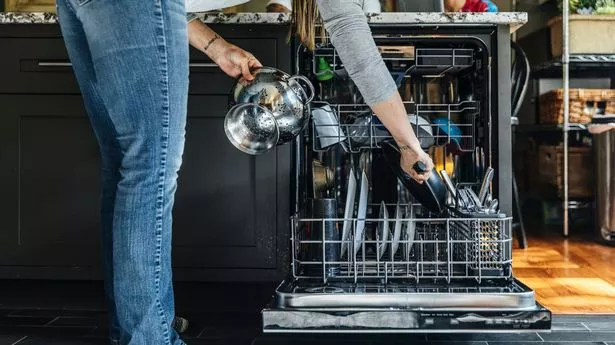8 Reasons and Fixes If Your Dishwasher Is Not Drying

Dishwashers simplify your life, but it can be annoying when they don’t complete the task, leaving your dishes clean but still wet. If your dishwasher isn’t drying properly, you can perform several tests to identify the cause. Discover the eight most common reasons your dishwasher isn’t drying and how to resolve the problem.
Improper Loading
Incorrectly loading the dishwasher can block the spray arms, preventing proper rinsing and causing water to collect in certain areas. Additionally, placing dishes too close together restricts air circulation, making it difficult for hot air to evaporate water and leaving dishes wet at the end of the cycle.
Here’s how to properly load your dishwasher:
- Place more oversized items, such as pots and pans, on the bottom rack, ensuring they do not obstruct the spray arms.
- Position plates and bowls facing inward and slightly angled for optimal water flow.
- Use the top rack for cups, glasses, and smaller items, spacing them apart to allow for adequate airflow.
- Avoid overstacking to ensure effective cleaning and drying.
Rinse Aid Issue
Rinse aid reduces water’s surface tension, allowing it to sheet off dishes quickly. Water droplets cling to dishes without it, causing spotting and longer drying times. This issue is particularly problematic for plastic items, which tend to dry more slowly.
If you think your dishwasher needs more rinse aid, try it. Most dishwashers have an adjustable setting for the amount of rinse aid dispensed per cycle. If you have hard water at home, you may need to increase this setting.
Use a high-quality rinse aid for optimal results, and regularly check the dispenser for clogs or damage.
Heating Element Failure
The heating element increases the dishwasher’s internal temperature to evaporate water from dishes during the drying cycle. If it malfunctions, dishes will not dry properly.
You can inspect the heating element for visible damage. If no damage is apparent, it is best to hire Appliance Repair SD. They can test the heating element and determine if it needs to be replaced.
Incorrect Cycle Selection
Dishwasher cycles are designed with specific functions and temperatures. For instance, eco-friendly or quick-wash cycles use lower temperatures and shorter drying times to conserve energy and water, which can result in dishes not drying adequately. Some cycles even skip the drying phase altogether.
To address this, choose a cycle that includes a drying phase and operates at higher temperatures. Refer to your dishwasher’s manual for details on cycle types. Typically, cycles labeled “Heavy Duty,” “Normal,” or those with a “Heated Dry” option provide the best drying results.
Clogged Vent
The dishwasher vent releases hot, moist air during the drying cycle. The humid air can’t escape if it’s blocked, leaving your dishes wet and musty-smelling.
Locate the vent on the top or side of the dishwasher door and check for a buildup of food particles, grease, or debris. Clean the vent carefully with a soft brush or cloth if you find any clogs. If cleaning doesn’t resolve the issue, the vent may need to be repaired by Appliance Repair SD or replaced.
Faulty Thermostat
The dishwasher’s thermostat regulates the air and water temperature. The drying phase won’t heat sufficiently if it malfunctions, leaving your dishes damp.
To test the thermostat, use a multimeter to check for continuity. If continuity is lacking, a professional will need to replace the thermostat.
Door Seal Problem
The door seal, or gasket, ensures the dishwasher remains airtight during operation. If the seal is damaged, worn out, or misaligned, hot air can escape, and cool air can enter during the drying cycle, leaving your dishes wet.
Check the door seal for cracks, tears, or other signs of wear. Clean the seal and the surrounding area to remove debris. If damage is found, the seal will need to be replaced.
Old Model
Outdated technology and worn-out components can cause an old dishwasher to stop drying effectively. Older models lack advanced drying features such as improved heating elements, venting systems, and insulation. Additionally, as components deteriorate over time, problems arise.
Before investing in a new appliance, perform maintenance on your old dishwasher. Check and replace worn-out parts like the heating element, door seal, and thermostat to ensure they are in good condition. Dishwasher repair costs typically range from $200 to $340 for minor fixes.
Consider investing in a new dishwasher if these repairs don’t significantly improve drying performance. The average cost of a new dishwasher, including installation, ranges from $1,040 to $1,540. Upgrading to a new model offers better performance, energy savings, and overall convenience.
Alpine Ca, Bonita Ca, Camp Pendleton Ca, Coronado Ca, Del Mar Ca, El Cajon Ca, Encinitas Ca, Escondido Ca, Imperial Beach Ca, Cardiff Ca, Carlsbad Ca, Chula Vista Ca, La Jolla Ca, La Mesa Ca, Lakeside Ca, Lemon Grove Ca, National City Ca, Oceanside Ca, Pacific Beach Ca, Point Loma Ca, Poway Ca, Ramona Ca, Rancho Bernardo Ca, Rancho Penasquitos Ca, Rancho San Diego Ca, Rancho Santa Fe Ca, San Marcos Ca, San Ysidro Ca, Santee Ca, Solana Beach Ca, Spring Valley Ca, Vista Ca Refrigerator repair, Freezer repair, Ice-maker repair, Wine-cooler repair, Washer repair, Dryer repair, Dishwasher repair, Stove repair, Oven repair, Range repairAreas that we cover:
Services that we provide
REQUEST SERVICE
Book a Repair Appointment

You can find us here
